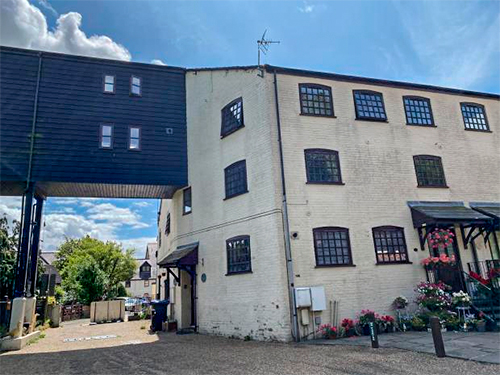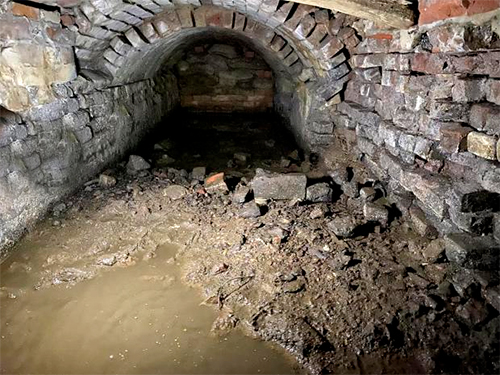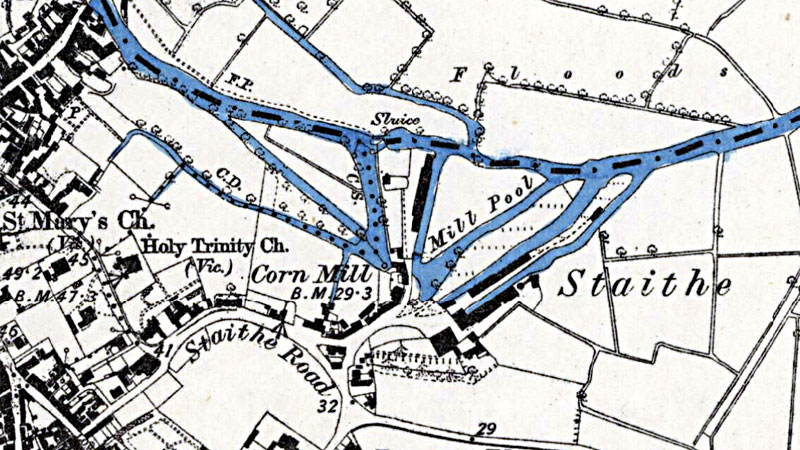|
|
|
September 1968
|
|
Bungay Mill
River Waveney |
|
|
|
September 1968
|
|
Bungay watermill, often known as Bardolph mill as it was originally part of the manor of Bardolph Ilketshall. |
|
There were almost certainly two adjacent mills in times gone by. |
|
During the American War of Independance 1775-1783 Bungay, Ellingham and Wainford mills produced flour for export to America. |
|
In April 1779 a dispute arose between Henry Gooch, Thomas Cotton and a group of local farmers who enlarged and deepened the watercourse of Chain Bridge Beck that was some 300 yards above the mill thus starving the mill of water. The dispute continued until at least 1781 and by 1784 Gooch and Cotton were bankrupt. It is possible that they were unable to fulfil their government contract to supply flour to America and if this was indeed the case they were probably faced with a considerable claim for damages. |
Henry Gooch was married to Mary Killett of Gorleston. In 1772 he was mayor of Gt Yarmouth and deputy mayor in 1774. After his bankrupcy he moved to London. |
|
In 1779 the
Mills were destroyed by fire and all the stock
therein being of the value together of £3,000 and upwards. |
|
Norfolk Chronicle - 6th March 1784 |
|
Charles Marston
who owned the mill in the early 1900s was
was born in Brooke in about 1844 and the 1861 census lists him as being apprenticed to Mr. S. Freestone in Hempnall_Field_Lane_Tower_Mill. By about 1870, Charles Marston was working Bungay watermill. |
|
Charles Candace Marston was born in the Mill House in 1882 to Charles Marston's second wife. He grew up learning every branch of his business as if it was his hobby. |
|
Wanted to purchase, in good preservation. a 5 or 6 horse power steam engine, with 7 or 8 h.p. boiler; what maker and when last at work. Charles Marston, Water Mill, Bungay, Suffolk. |
|
Wanted an undershot Water Wheel 12ft. to 15ft. high, 10ft. to 16ft. wide, with first motion wheels. Secondhand or new. Apply to Charles Marston, Water Mill, Bungay, Suffolk. |
|
6lb flour sack |
|
Charles Marston's self raising flour plant was some 100 yards away from the mill occupying premises that later became the Staithe Garage. Harry Hall worked there and sold flour to customers in Kings Lynn, Norwich and Ipswich, normally in 10 stone bags. Harry Hall was brother in law to Charles Candace Marston who had married Harry's sister Kate (1883-1972). |
|
Billy Patrick was the carter to Charles Marston and was known as 'Midnight' Patrick on account of his frequent late return home due to his habit of calling in at numerous pubs whilst on his rounds. On one occasion, whist passing under an oak tree, he heard the voice of God telling him to give up drink. This he promptly did and subsequently became a staunch member of Bungay Salvation Army. |
|
|
|
11th April 2004 |
|
At one point after the mill had been rebuilt, the wheel was replaced by a turbine installed by Gilbert, Gilks & Gordan of Kendal. However, the changeover only took place on the understanding that if the turbine did not perform as well as the wheel, the wheel would renewed and reinstalled. This is precisely what happened. |
|
|
|
11th April 2009
|
I have spent the last year researching diesel oil engines made by the Brush Electrical Engineering Co Ltd of Loughborough. During this research, I found the production records for these engines and can advise that in October 1934, Charles Marston of Bungay, Norfolk (tel: Bungay 40) ordered a Brush engine. Built under works order E130 and carrying serial number 176, it was a four cylinder diesel, type 4S10, developing 200 hp at 290 rpm. It was delivered to Marston in March 1935. There is a general arrangement drawing of this engine, but unfortunately, it does not show much of its situation within the mill. |
Repair work to start at Bungay staithe to protect town mill |
Repairs to stop a 400-year-old watermill from falling into a river are finally due to begin this month, following a three-year row over who is responsible for the work. |
 |
LAST MINUTE DELAY Even at this late stage, delays have continued. Reinforcement work beneath the bridge was due to start on July 10. But this was put back after another dispute over electrical wires which run across the bridge. Mr Child said: "Because of the nature of these hazards my contracted repair team cannot get working access below the bridge until they have been made safe or removed." Work is now due to start on July 24. DEAL STILL HOLDS Despite the years of dispute and recent setback, a deal still holds between Mr Child and the council. "What broke the bridge was the crossing of canoeists and cars. We had 600 movements across the bridge a day. It was absurd," he said. "I am fearful that even after the work is complete, it will be this which threatens the bridge structure again. "I am keen to get the best deal possible for this for the community because this is just purely unsafe. If this dispute wasn’t so nasty it would be hilarious." An ESC spokesman said: “We have been negotiating at length with the owner to agree the extent of repairs and the contribution various parties using the bridge should make towards the cost of repairs. “The bridge gives access to various premises, including some council-owned land, while also providing, in part, structural support to a private residence. “While East Suffolk Council does not see any purpose to changing the current ownership of the bridge, it has committed to funding 30pc for the required repairs, commensurate with its use of the structure. “Based on the information provided, East Suffolk Council understands the damage to this privately owned bridge results from a combination of various impacts. "These include water flow and flood surges, and associated debris impact, along with the fact that the bridge provides structural support to the adjoining property, and the various vehicular and foot traffic it carries. "The nature and extent of past and ongoing inspection and maintenance is also very likely to be a contributory factor.” |
 No. 2 Culvert |
TOWN'S POWERHOUSE Bungay's Staithe, its watermill and maltings were once the centre of the town's economy. Commercial activity in the area declined after the silting up of the Waveney in the early 1930s. The mill’s water wheel and machinery were removed in the 1950s and the millstream grassed over a few years later. Bruno Brown, Eastern Daily Press - 18th July 2023 |
Millstream house for sale in Bungay on River Waveney |
A former millhouse on the banks of the River Waveney has been listed on the market for £650,000. |
 |
COUNCIL FALLOUT Last year Mr Child had to fork out a substantial sum of money to pay for urgent repairs to the bridge beneath the property to prevent the building from collapsing into the river. Mr Child was at loggerheads with East Suffolk Council with regard to who should pay for the repairs. Mr Child says the bridge damage was caused by an increase in the number of people flocking to the spot, especially since the pandemic. At one stage, he recorded 600 crossings by vehicles in the space of a day, each putting further strain on the structure. HISTORICAL SIGNIFICANCE Bungay Mill, known as Bardolph's Mill, has risen from the ashes of at least six fires before its survival into the late 19th century when the Victorians restored it. Bungay's Staithe's watermill and maltings were once the centre of the town's economy as the "Broads network" was paramount for trade. Commercial activity in the area declined after the silting up of the Waveney in the early 1930s. The mill’s water wheel and machinery were removed in the 1950s and the millstream grassed over a few years later. |
 Tim Child pictured beneath the millstream bridge |
TOWN'S POWERHOUSE Bungay's Staithe, its watermill and maltings were once the centre of the town's economy. Commercial activity in the area declined after the silting up of the Waveney in the early 1930s. The mill’s water wheel and machinery were removed in the 1950s and the millstream grassed over a few years later. Bruno Brown, Eastern Daily Press - 15th June 2024 |
|
Mill advertised for sale by Musker McIntyre for £650,000 - June 2024 |
 |
O. S. Map 1882-1884 |
|
1618: Henry
Whight & Edmund Cooke |
If you have any memories, anecdotes or photos please let us know and we may be able to use them to update the site. By all means telephone 07836 675369 or
|
| Nat Grid Ref TM 34058984 | Copyright © Jonathan Neville 2005 |